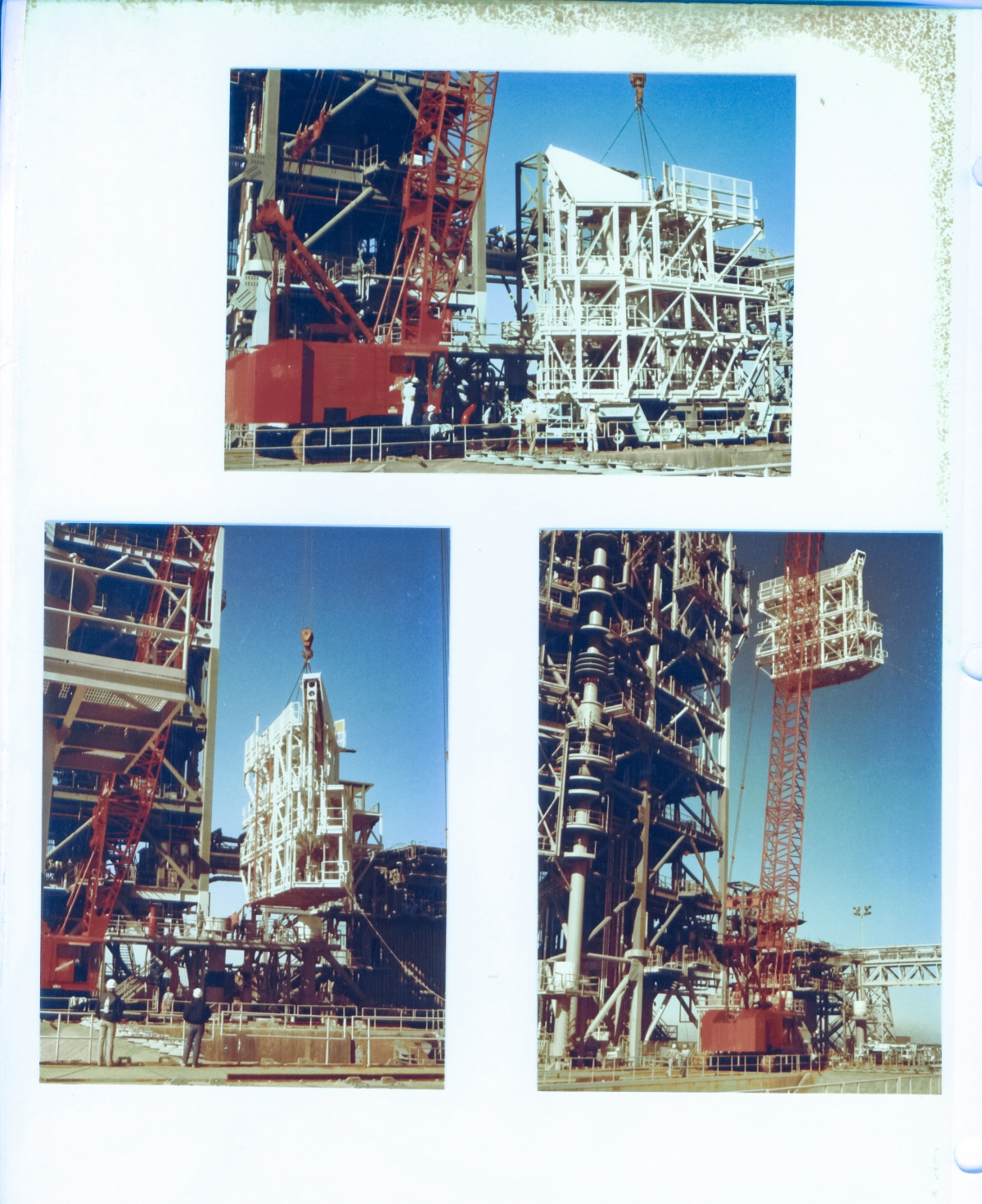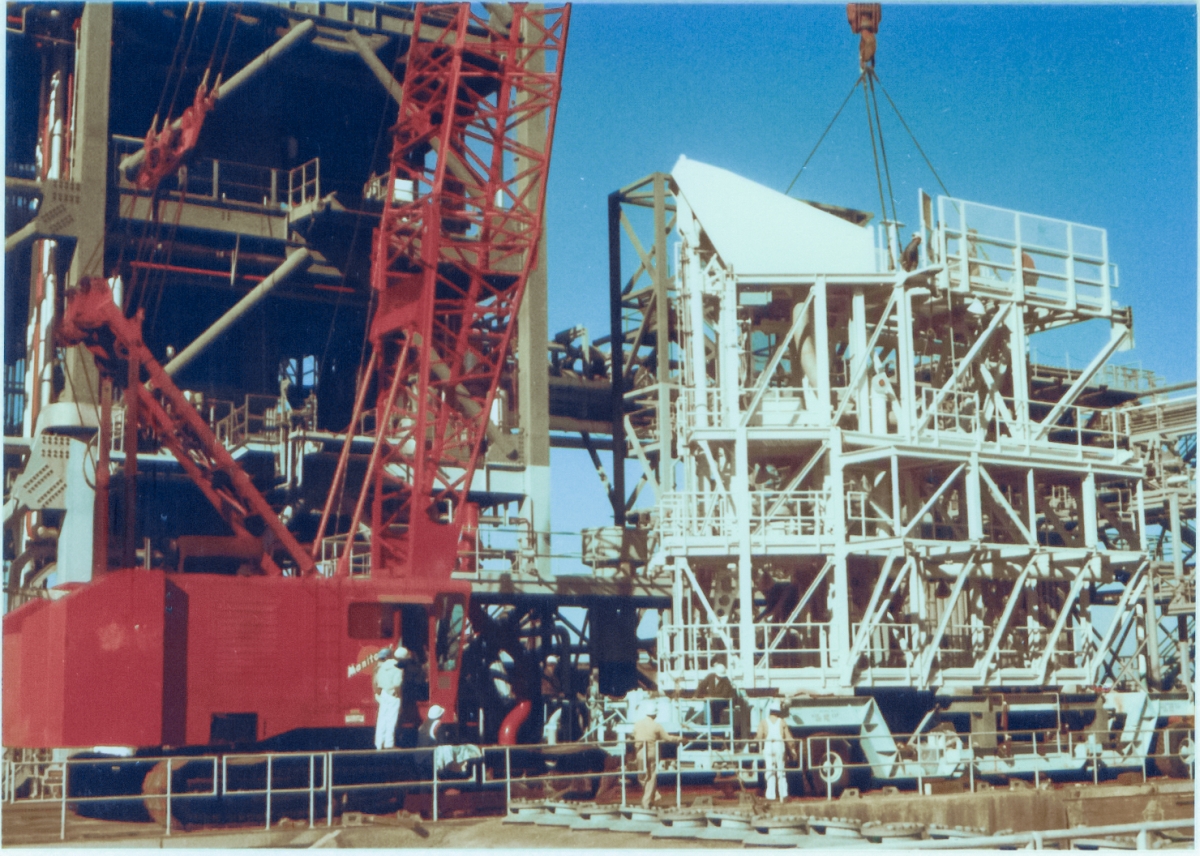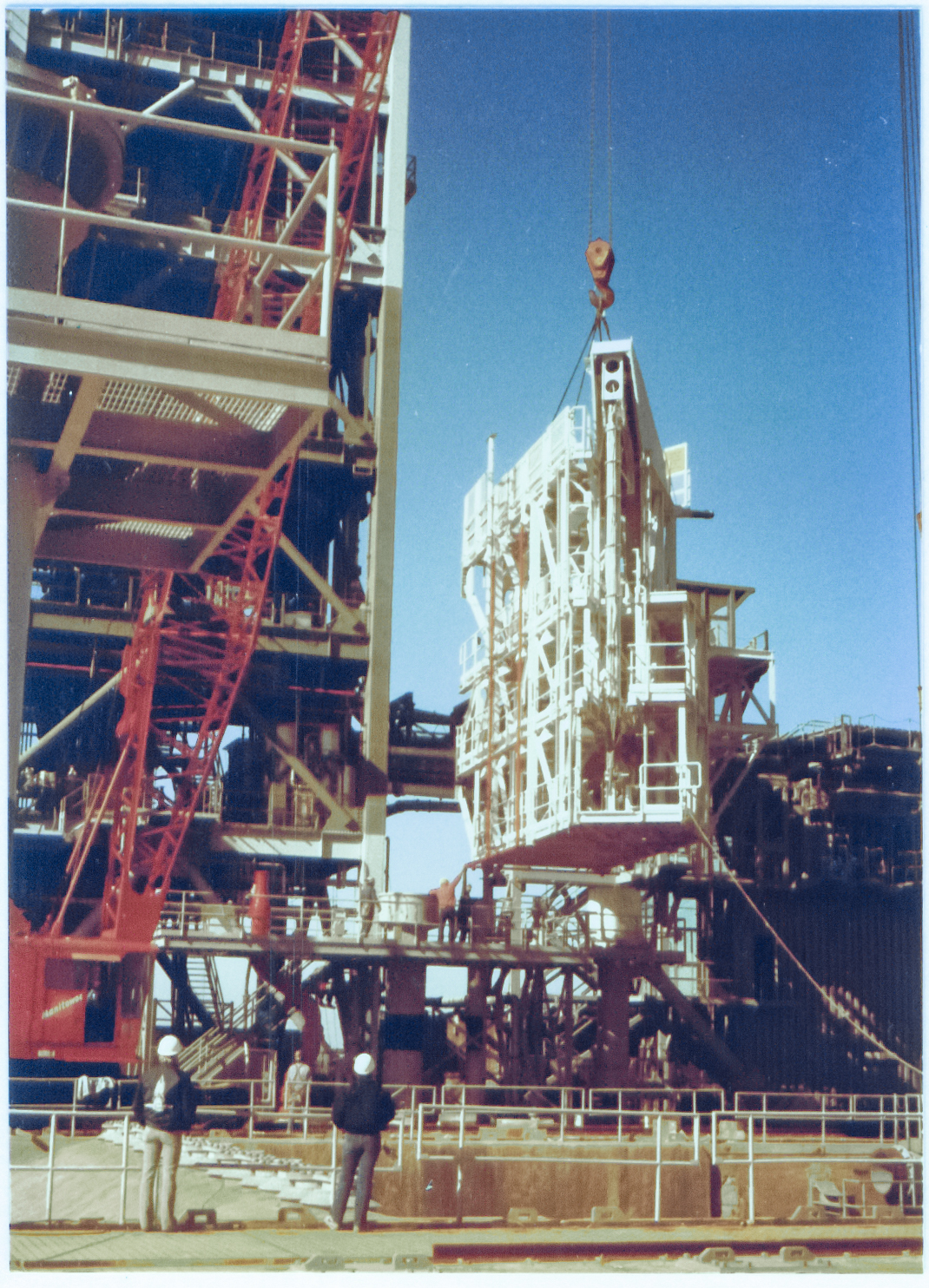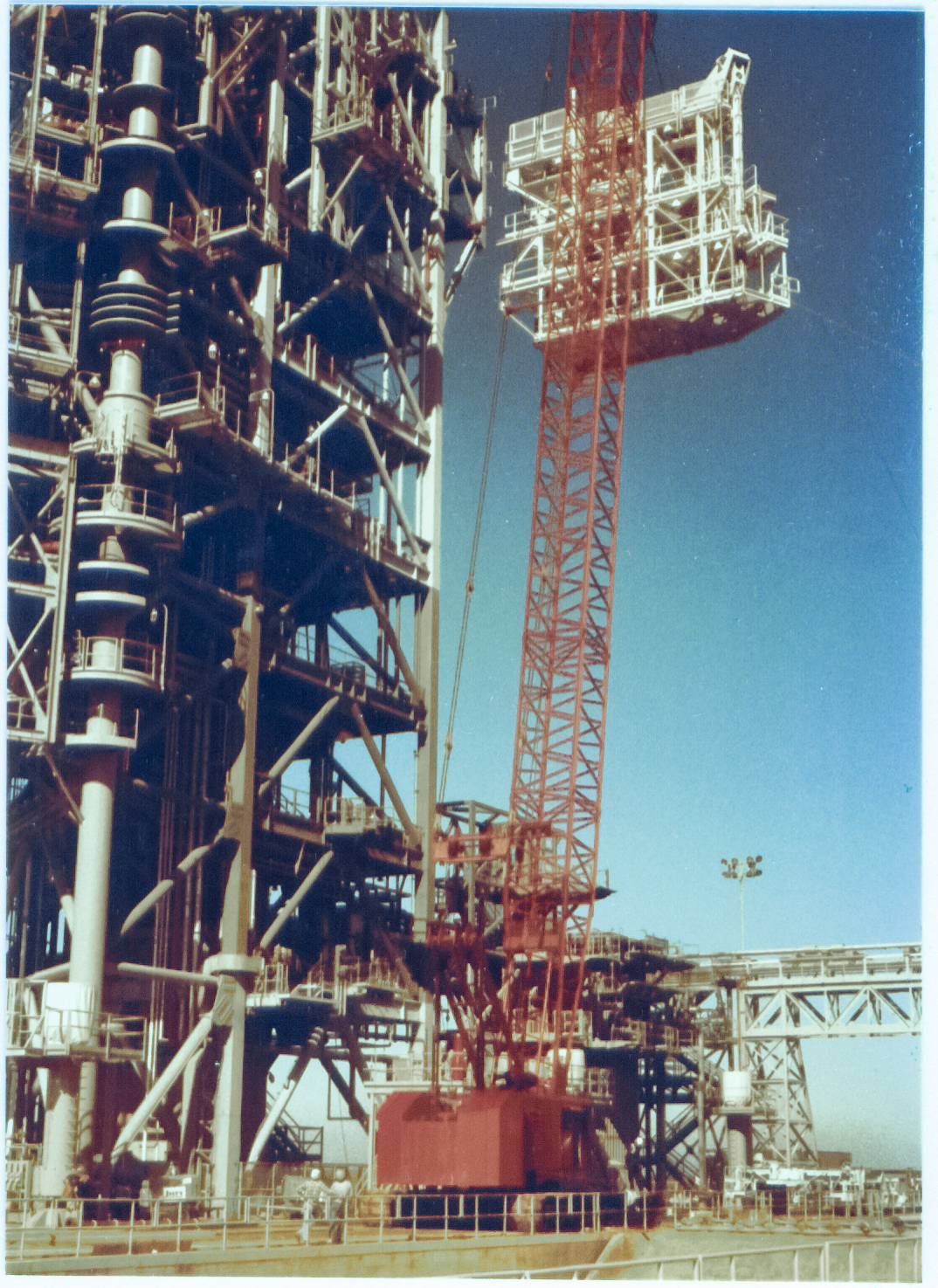Space Shuttle Launch Complex 39-B Construction Photos
Page 18
IAA Lift 1
Intertank Access Arm Lift page 1 (Original Scan)
The IAA is also known as the Gaseous Hydrogen Vent Arm, and it supports what's known as the "Elephant's Trunk" which connects to the External Tank, and carries off vented hydrogen that accumulates in the area between the LOX and LH2 tanks inside the External Tank. At launch, the Elephant's Trunk is blown loose and flops down and away from the Shuttle as it takes off.
This thing always seemed overdesigned to me. It's a monster, and there seems to be way too much of it for just handling the Elephant's Trunk. It's also unnervingly close to the orbiter's left wing as the vehicle comes up off of the pad, and I've heard scary stories about the tip of that left wing coming alarmingly close to the steel structure of the IAA, especially on launch days when the breeze is out of the southeast, pushing the orbiter directly toward the damn thing. But they never hit it, so I guess that's ok then, right?
Additional commentary below the image.

Top:
(Reduced)

Ok, we've spent an awful lot of time over on the RSS lately, so let's go back to the FSS for a while, ok?
And what better way to go back to the FSS than with the lift of a monstrosity like the Intertank Access Arm?
I mean, really, get a look at this thing!
Nobody liked the IAA with the sole exception of the lead engineer who was proudly responsible for it, and who worked over in the same field trailer (And don't let that singular tense of the word trailer fool you. They routinely, all over the place, would butt trailers together side-by-side, remove the intervening walls, and thereby create surprisingly-large open-space temporary work areas with them.) that Jack Petty and the rest of those people all worked in.
Why this thing had to be as stupidly big as it was, and why it had to protrude as far toward the flame trench as it did, out toward the Space Shuttle as it lifted off into the air above the pad, nobody ever seemed to know. During my entire half-decade out on 39-B while we were building it, I asked anybody and everybody why this thing had to encroach so damn far over toward a flying Space Shuttle, which, on days with a southeast breeze, would be drifting as it rose away from the MLP, drifting directly toward the unfeeling steel of this monster, and never once did anybody have anything to offer about it above and beyond "because," which I never regarded as a particularly satisfactory "answer."
The IAA always scared me, in similar fashion as the whole Shuttle Centaur thing scared me. I could never bring myself to trust it in the slightest degree. Unlike Shuttle Centaur, this thing wound up getting built and used, and it never got them.
But there were those stories, and although I have no idea if or how much to actually believe any of them, there were apparently a couple of hair-raisingly close calls with this thing involving the Space Shuttle's left wing, drifting in an unpleasant direction towards the IAA, on days when they launched with a southeast breeze blowing, one of which remains deeply burned into my memory, and involves the stated distance of three feet(!) total clearance between the tip of the orbiter's left wing and this nightmare, as the orbiter was doing its best to get up off the pad and get the hell away from all this crap as fast as possible, in the first few seconds after SRB ignition.
How it ever got approved by NASA in the first place also remains unknown.
But it did, and it was, and that was that.
The elephant's trunk that this thing was designed and built to support, was nothing fancy, nothing particularly unique, or large, or heavy, but instead was simply a vent line connected to the ET to duct away the explosive hydrogen gas that would otherwise build up inside the "intertank" (as in "between tanks," there being a tank for oxygen stacked directly on top of a tank for hydrogen, making up the whole of the External Tank) area, and send that hydrogen some place safe, like maybe over to the Flare Stack or something like that.
Here's a NASA video showing them disconnecting it and manually retracting it back to its stowed position against the IAA, and in addition to giving you a good look at the trunk in its working environment, you also get a realistic take on the sights and sounds associated with the real-world "nuts and bolts" goings-on out on the towers. This is probably the best video I've ever encountered for the purposes of bringing the viewer out onto the structure, with a Space Shuttle on the pad, and immersing them into the overall ambiance of things. Exceedingly well-done video.
In this image, the IAA is still sitting on the specialized trailer it was brought up to the pad deck on, with its four-leg lifting sling hooked on to the Manitowoc, ready to go. That might be the crane operator standing on top of the crane's crawler tracks, but I cannot know for sure. Right next to him, standing on the pad deck, is, of course, Wade Ivey. Farther to the right, two gentlemen in yellow, one with white coveralls, plus another guy between them up on the trailer with a white hard hat, look to be associated with whomever it was that rigged and worked that trailer and are not Ivey ironworkers. Up on top of the IAA, a couple of ironworkers can be seen working the final adjustments to the lifting sling. We're getting very close to picking that thing up, here.
Of note is the fact that the swing-arm part of the IAA is not anywhere to be seen. It attaches in the area below, and just to the right of, the white, somewhat-triangular looking, blast hood up on the top left of the IAA, and folds back to the right, well past the right edge of the IAA as viewed in this image. My guess is that the swing arm, sticking way the hell out to the side over there, constituted an unwanted interference with this lift, so they decided to go without it. But that's a guess, and I really do not know the story on that one.
Bottom Left:
(Full-size)

And now the transport trailer is gone, we're up in the air, rotated around into our proper orientation, an ironworker on the tag line, and we're underway.
Zoom in. Give it a nice blurry two-hundred percent zoom. Three, even. Look close at the bottom left corner of the IAA. I count three ironworkers over there on the platforms that are visible in the areas around the MLP mount pedestal and the SSW water headers, two of whom are hands-on with it. Once again, we're hanging in the air, and we're close to existing structure, with a very large, very heavy, and very unforgiving object.
From this angle, we're looking directly towards the elephant's trunk, hanging straight down in its latched position, starting from the very top, under the corner of that blast hood, extending all the way to that gap in the handrail on the bottom framing level of the IAA.
Follow the line of the blast hood, down, away, and to the right, where you can see some handrail with a yellow warning sign on top of it. Immediately below that piece of handrail, you can see the support for the top pivot point of the swing arm, sticking out against the background of the sky to the right.
Bottom Right:
(Full-size)

And now we're closing in on our final destination, which is sticking out a little bit from the main envelope of the FSS immediately to the left and just a little above the level of the suspended IAA.
There's an ironworker on the top level of that FSS support framing, watching closely as the IAA moves in on things.
Also, from this angle, you get a pretty good look at the amazing number of circular crossover platforms there were on the hinge column. There really was a lot of stuff going between the FSS to the RSS via cables, wires, ducts, pipes, tubes, and who knows what else that had to bend and flex as the RSS was swung around from de-mate to mate and back again, and I count thirteen of them, with a fourteenth mostly out of frame at the top, not including the access platforms for the lower hinge column thrust bearing, of which there was a total of only two, that bore the entire weight of the RSS over on this side of things. Maybe I'll get a chance to talk about those bearings here later on some time. Fairly impressive items, those bearings were.
Return to 16streets.comACRONYMS LOOK-UP PAGEMaybe try to email me? |